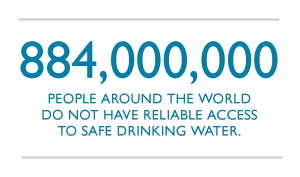Exploring the complexities of our water system

Little seems simpler than the water we drink: We turn on the tap and trust it to be safe, and even tasty. Yet there are many factors that contribute to the safety and environmental impact of water. Professor Ketra Schmitt, of the Engineering and Computer Science Faculty’s Centre for Engineering in Society, is keeping track of as many of them as possible.
Water is not the only thing that Schmitt has studied: She has investigated such varied subjects as the lasting economic and social effects of terrorism, electromagnetic interference in hospitals, and the safety of seafood. What draws together these seemingly unrelated areas of study is her commitment to tackle huge topics that are shaped by many different variables.
“These are problems that tend to be complex,” she says. “My overarching interests are in taking disparate types of information that aren’t easy to put on the same scale, and trying to find innovative ways to combine them.”

Slated to be a member of the Faculty’s forthcoming Institute for Water, Energy, and Sustainability, Schmitt has focused her most recent work on contaminants in water. In Canada, it is an important issue precisely because we have no federally mandated drinking water regulations. Schmitt, working with graduate student Ryan Calder, hopes to understand the many wide-ranging factors that enter into producing and distributing clean water.
She explains, “I’d like to ask whether or not, in the long run, our current approach to delivering water is sustainable, economically efficient, and really the best idea.”
She hopes to help design a means of regulating water “that is predictive and anticipatory, rather than reactive.” That means scanning for emerging threats and staying on top of toxicological trends. It might also mean changing our approach to infrastructure. We clean an enormous amount of water, most of which we water our lawns with, or flush down the toilet.”
Alternate methods of regulation and delivery, she says, are certainly possible. She presents, for example, the idea of a twin system of water delivery, in which taps deliver water that has not had all trace contaminants screened out, while water for drinking and cooking is delivered separately, via “home-filtration systems, water delivery, a tanker-truck that fills local water cisterns, or some other kind of water infrastructure.”

Possible scenarios comprise a huge number of variables that seems impossible to monitor, but this prospect appears only to inspire Schmitt. Most recently, she published a paper in the journal Environmental Science & Technology that explored the uncertainties at the core of the research models upon which the US Environmental Protection Agency’s safe drinking water policies are based. To her, uncertainty is simply a puzzle.
“There may be multiple well-conducted studies that give us what look like different answers,” she says, “but we probably just don’t understand the things that went into making those numbers different. So the goal is coming up with a richer depiction of what reality is.”
Related links:
• Concordia's Centre for Engineering in Society
• Concordia's Institute for Water, Energy and Sustainability